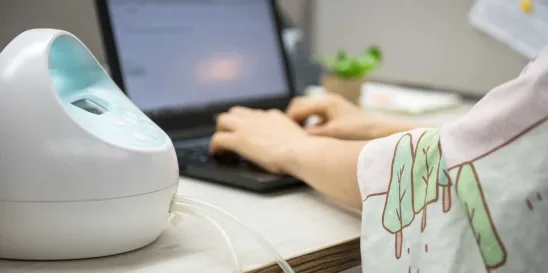Implementation of the requirements for compliance with the Providing Urgent Maternal Protections for Nursing Mothers Act (PUMP Act) has presented unique challenges to employers in the retail and restaurant industries due to limited space and the often fast-paced nature of business operations driven by customer demand. The U.S. Department of Labor (DOL) recently issued industry-specific guidance for employers in these particular industries, providing examples tailored to address some of the most common questions.
Quick Hits
- The PUMP Act extends legal protections for the right of nursing employees to express breast milk in the workplace through a nursing child’s first year after birth.
- The act requires covered employers to provide “reasonable break time” and a private space, other than a bathroom, to express breast milk.
- PUMP Act enforcement remedies took effect on April 28, 2023.
- The DOL has published guidance for the retail and restaurant industries in the form of an on-demand webinar, associated presentation slides, and a frequently-asked-questions (FAQ) publication.
Employers have been subject to remedies related to the enforcement of the PUMP Act since April 28, 2023. On May 17, 2023, the DOL published a field assistance bulletin to assist in the enforcement of the PUMP Act generally.
The PUMP Act
The PUMP Act, which President Biden signed into law on December 29, 2022, amended the Fair Labor Standards Act (FLSA) to extend the coverage of the right to express milk at work to nearly all workers covered by the FLSA. The law went into effect immediately after signing, but additional remedies for enforcement of the act’s protections took effect on April 28, 2023.
For employers with traditional commercial office space, ensuring compliance with the act’s requirements may have presented fewer challenges due to the availability of private, secure spaces that could be readily modified for use as a permissible space for nursing mothers to express milk, as well as greater latitude in freely permitting employees to take lactation breaks when needed.
Retail and restaurant employers have likely encountered greater difficulties in identifying a permissible location that is compliant with the act due to lack of physical space and the inherent challenge associated with permitting employees to take lactation breaks on demand. A common example is that of a cashier needing to express milk who is suddenly confronted with a long line of customers waiting to be checked out. These situations arise because business demands fluctuate based on customer flow, which can be forecasted to some degree, but is otherwise outside of the control of employers in the retail and restaurant industries.
Retail and Restaurant Industry–Specific Guidance
The DOL’s guidance reminds employers that the act does not require a permanent space dedicated for the expression of milk. Rather, an employer may remain compliant with the act by temporarily designating a space or by making a space available when needed by the employee to express milk. Importantly, a bathroom is never an acceptable space under the PUMP Act.
The DOL provided an example of a retail sales manager being afforded a temporary, screened-off space in the storage room of a store, with a table and chair put into place, and appropriate signage affixed to the screened-off area to warn others that the space is restricted. In providing this example, the DOL included the reminder that an employee may cover or unplug any video surveillance otherwise in place while the space is being used for the expression of milk. The DOL noted in its field assistance bulletin that “an employee must be free from observation by an employer provided or required video system, including a computer camera, security camera, or web conferencing platform, when they are expressing breast milk, regardless of the location they are working from.”
The DOL also provided an example involving the collaboration of multiple fast-food restaurants located within the same small vicinity, such as a food court area of a shopping center. There, the DOL suggested the restaurants align with each other to collectively identify a shared space in reasonable proximity for all of their employees to be able to use to express milk. As there might be more than one worker utilizing the area simultaneously, the DOL recommended the use of an electronic door lock with the code given to those using the space and the use of partitions to create multiple, secluded areas inside the room for added privacy. Finally, the room would be equipped with sufficient tables, chairs, a sink with running water, and a refrigerator or cooler for storing expressed milk.
This suggestion could likewise be applicable for smaller retailers in close proximity that might otherwise lack the individual space to create an acceptable lactation area, even on a temporary or ad hoc basis. The DOL noted that the use of a manager’s office, if available and able to be secured from intrusion or observation, remains a viable option as well.
Retaliation Prohibited
The DOL guidance also reminds employers of the act’s anti-retaliation provisions, as prohibited acts may take many different forms of adverse action up to and including termination of employment. For example, performance for retail employees may be measured through the attainment of specific sales quotas. The DOL cautioned against managers requiring retail workers to work additional hours to make up for time lost due to lactation breaks or to meet quotas, as this would be retaliation under the act.
Other Considerations
The DOL’s industry-specific guidance does not address the practical challenge faced by retailers and restaurants relative to employees needing to take lactation breaks without delay but also handling variable customer flow and demand without interruption. The Office on Women’s Health (OWH) of the U.S. Department of Health and Human Services provided some suggestions in this regard. OWH’s guidance encourages flexibility and communication between the nursing mother and management, such that a manager or supervisor can quickly fill in for an employee if a lactation break is needed during a rush period. The OWH also encouraged employers to consider the build-out of a defined space when renovations occur.
The DOL intends to issue additional industry-specific guidance over the next few weeks, including for the transportation industry and the educational services sector.





 />i
/>i

